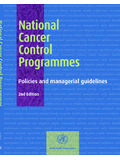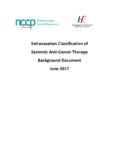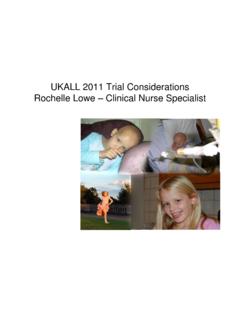Transcription of CANCER AND CHILDREN - World Health …
1 1 TRAINING FOR THE Health SECTORTRAINING FOR THE Health SECTOR[Date [Date ..Place Place .. ]Organizer] CHILDREN AND CANCER CHILDREN AND CANCER CHILDREN 's Health and the EnvironmentWHO Training Package for the Health SectorWorld Health <<NOTE TO USER: Please add details of the date, time, place and sponsorship of the meeting for which you are using this presentation in the space indicated.>> <<NOTE TO USER: This is a large set of slides from which the presenter should select the most relevant ones to use in a specific presentation. These slides cover many facets of the problem. Present only those slides that apply most directly to the local situation in the region.>>2 CHILDREN and CancerChildren and CancerCHILDHOOD CANCERCHILDHOOD CANCEROBJECTIVES To discuss childhood CANCER To address the links between childhood environments and adult onset of CANCER To present current knowledge of causation and environmental risk factors To discuss CANCER clusters To present educational and preventive measures<<READ SLIDE>>3 CHILDREN and CancerChildren and CancerOVERVIEWOVERVIEW1.
2 INCIDENCE AND TYPES OF CHILDHOOD CANCER2. CAUSES, RISK FACTORS AND HYPOTHESES3. BIOLOGICAL PROCESSES LEADING TO CANCER DEVELOPMENT4. EXPOSURE ASSESSMENT AND ITS CHALLENGES5. INVESTIGATING POTENTIAL CANCER CLUSTERS6. QUESTIONS FROM PARENTS<<READ SLIDE>>4 CHILDREN and CancerChildren and CANCER * Rates are per 100,000 population and age adjusted to the 2000 US standard LEADING CAUSES OF DEATHTEN LEADING CAUSES OF DEATH( CHILDREN aged under 15 years) 2006 CAUSE OF DEATHNO. OF DEATHS% OF TOTAL DEATHS DEATH RATE* RANKALL (unintentional injuries) (homicide) self-harm (suicide) & lower respiratory other Based on US Mortality Data, 2006, National Center for Health Statistics, Centers for Disease Control and Prevention, 2009In the United States, CANCER is the second most common cause of death among CHILDREN between the ages of 1 and 14 years, surpassed only by accidents.
3 Reference: US Mortality Data, 2006. National Center for Health Statistics. Centers for Disease Control and Prevention, and CancerChildren and CancerINCIDENCE CHILDHOOD CANCER INCIDENCE CHILDHOOD CANCER (Globally)(Globally) per 100,000 < 15 years of per 100,000 < 20 years of age per 100,000 Ries LAG, SEER 2000-2004 INCIDENCE CHILDHOOD CANCER INCIDENCE CHILDHOOD CANCER ( 2006)( 2006) Childhood160,000 new cases/year < 15 years of age90,000 deaths/year < 15 years of ageFerlay J, IARC CANCER Base N 5, 2004 Malignancies in childhood are relative rare and prognosis has been improving in the last three decades as a result of more accurate diagnoses and improved treatment strategies. Adult malignancies occurring after 20 years of age are 20-30 times more common in general.
4 References: Ferlay J et 2002: CANCER incidence, mortality and prevalence CANCER Base N 5 Version Lyon, IARCP ress. 2004. SEER CANCER Statistics Review 1975-2004. Ries LAG et al.(eds). National CANCER Institute. Bethesda, MD, based on November 2006 SEER data submission, posted to the SEER web site, 2007. 6 CHILDREN and CancerChildren and CancerINCIDENCE CHILDHOOD CANCER INCIDENCE CHILDHOOD CANCER ( CHILDREN aged under 15 years)YearRate per 100000 person-yearsLeukaemiasBrain & other nervous systemNon-Hodgkin's lymphomasHodgkin's diseaseAll non-epithelial skinBased on Linet MS et al. J Natl CANCER Inst 1999;91(12):10520 Overall, in CHILDREN less than 15 years of age, in the industrialized World , childhood CANCER is listed as the 4thmost common cause of trend patterns of common childhood cancers have recently been evaluated because of concerns that they may be on the rise:-For childhood leukaemia there was an abrupt increase in incidence between 1983 and 1984, however, rates have been declining between 1989 and 1995.
5 -For brain and CNS cancers there was a modest increase in incidence from 1983 to 1986 and rates then stabilized between 1986 and statistically significant increases that were reported in the mid 80 s are now thought to be a result of diagnostic improvement or changes in reporting rare skin cancers such as dermatofibrosarcoms, there has been a 40% increase between 1975 and from the United States (US) shows that the incidence rate of cutaneous malignant melanoma (CMM) in 15-19 year olds increased per year between 1973 and 1995, for a total increase of 85%.References: American Academy of Pediatrics Committee on Environmental Health . In: Etzel RA, ed. PediatricEnvironmental Health , 2nd ed., 2003. Hamre MR, et al. Cutaneous melanoma in childhood and adolescence.
6 Pediatric Hematology & Oncology, 2002;19(5):306-17. Linet MS et al. CANCER Surveillance Series: recent trends in childhood CANCER incidence and mortality in the United States. J Natl CANCER Inst,1999;91(12):1052 Graph Linet MS et al. CANCER Surveillance Series: recent trends in childhood CANCER incidence and mortality in the United States. J Natl CANCER Inst,1999;91(12):1052. Oxford University Press. Used with copyright permission7 CHILDREN and CancerChildren and CancerIncidence per million CHILDREN (under 15 years old) in selected countries categorized by mean per capita gross national incomeIncidence data are from the International Agency for Research on CANCER . Low-income country (LIC): the mean per capita annual income in 2005 is less than US $825;high-income country (HIC): the mean per capita annual income is more than $10, per capita figures in US dollars.
7 Gross national incomes were taken from the World development indicators database of the World Bank for sarcoma accounted for nonleukemia cancers per million per year in Uganda and in on Scott CH, CANCER , 2007 INCIDENCE CHILDHOOD CANCERINCIDENCE CHILDHOOD CANCERC ountryCancerincidenceLeukemiaincidenceNo nleukemiaincidenceGross Nationalincome*CountryCancerincidenceLeu kemiaincidenceNonleukemiaincidenceGross Nationalincome*Low-incomecountries (n = 9)1021685491 High-incomecountries (n=9) Kingdom New Guinea greatest variation in incidence of paediatric cancers occurs in comparisons of high-income to low-income countries and may derive from incomplete ascertainment of paediatric CANCER occurrence, different risk factors ( , paediatric Burkitt lymphoma in sub-Saharan Africa is associated with Epstein Barr virus infection in conjunction with malaria, whereas Burkitt lymphoma in industrialized countries is not associated with these infectious conditions), or differences in risk among different ethnic or racial population subgroups.
8 Reference: Scott CANCER epidemiology in low-income countries. CANCER , 2007, 112;3:461-472 8 CHILDREN and CancerChildren and CancerCAUSES OF CHILDHOOD CANCERSCAUSES OF CHILDHOOD familial and genetic factors (5-15%) Environmental exposures & exogenous factors (<5-10%) 7575--90%90%In a small percentage of childhood cancers, familial or genetic factors are thought to predispose the child to CANCER . An even smaller percentage of childhood CANCER has an identified environmental link. Although some studies have concluded that genetic factors make a minor contribution to most types of CANCER (Lichtenstein et al. (2000) studied 44,788 pairs of twins to determine the relation role of genetics vs. environmental factors in CANCER ), the majority of childhood cancers, however, remain poorly understood and causes are unknown.
9 It is through the vigilance and investigation by practitioners when a new case of childhood CANCER is diagnosed that causative factors are found. There is no doubt that it is a combination of factors acting concurrently and sequentially that are involved with any individual case of childhood : Birch JM. Genes & CANCER . Arch Dis Child, 1999, 80:1-3. Lichtenstein P et al. N Engl J Med, 2000, 13;343(2):78-85 9 CHILDREN and CancerChildren and CancerMULTIMULTI--CAUSAL! CAUSAL! --MULTIMULTI--GENERATIONAL?GENERATIONAL? Based on Anderson LM, Environ Health Perspect, 2000, 108(suppl 3):573-594 MaternalPaternalEnvironmental exposuresGene pooleg. Retinoblastomaeg. Leukaemia (trisomy)eg. Vaginal adenocarcinoma (DES)eg. Leukaemia (X-ray)eg. Hepatocellularcarcinoma (hepatitis B virus)Parental grandmothersParental preconceptionalGestationalPostnatalParen tal gametesDirectTransplacentalCancers are assumed to be multivariate, multifactorial diseases that occur when a complex and prolonged process involving genetic and environmental factors interact in a multistage : Anderson LM et al.
10 Critical Windows of Exposure for Chidlren s Health : CANCER in Human Epidemiological Studies and Neoplasms in Experimental Animals Health Perspect,2000, 108(suppl 3) In humans, CANCER may be caused by genetics and environmental exposures; however, in the majority of instances the identification of the critical time window of exposure is problematic. The evidence for exposures occurring during the preconceptional period that have an association with childhood or adulthood cancers is equivocal. Agents definitely related to CANCER in CHILDREN , and adulthood if exposure occurs in utero, include: maternal exposure to ionizing radiation during pregnancy and childhood leukemia and certain other cancers, and maternal use of diethylstilbestrol during pregnancy and clear-cell adenocarcinoma of the vagina of their daughters.















